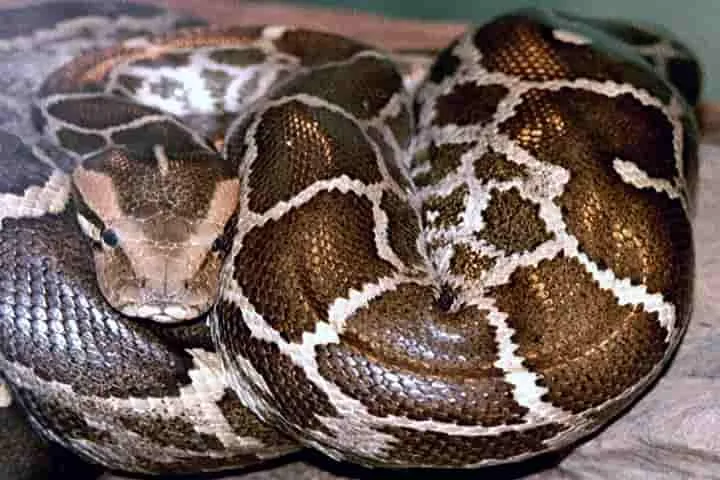

In a reminder of its evolution, snake embryos, such as pythons, still form hindlimb buds that disappear during development (Pic. Courtesy wikimedia commons)
<p>
<strong>Evolution is a long-drawn process and it is rare for scientists to come across fossils or specimens which are in the transition phase, that is moving from one stage to another. Two fossils which are 308 million years old got researchers interested as they depicted animals in this evolutionary limbo &ndash; that is caught between two forms &ndash; snake-like and lizard-like, stated a report in livescience.com.</strong></p>
<p>
The bodies of the two creatures are curving and distinct as they possess two lizard legs in the back but there are no limbs in the front.</p>
<p>
In their study of these fossils, details of which appeared in the journal Nature Ecology &amp; Evolution, scientists named the new genus and species as Nagini mazonense and these typify loss of limbs in amniotes.</p>
<p>
Amniotes are those creatures whose embryos are protected by an amniotic sac and in these are included reptiles, birds and mammals.</p>
<p>
<strong>Also read: <a href="https://www.indianarrative.com/science-news/new-study-shows-boa-snakes-switch-breathing-points-along-ribs-when-killing-prey-160668.html">New study shows Boa snakes switch breathing points along ribs when killing prey</a></strong></p>
<p>
Arjan Mann, the study&rsquo;s lead author said such transitional forms are rare and described them as &ldquo;something in-between&rdquo; an animal which has four limbs and one which has none.</p>
<p>
Mann is a vertebrate palaeontologist and postdoctoral fellow at Washington DC&rsquo;s Smithsonian National Museum of Natural History.</p>
<p>
The N. mazonense hail from a set of animals which are known as molgophids. In the past Mann and other researchers had found molgophids whose forelimbs had shortened and had no digits. In the present case this was the first instance of animals whose forelimbs were missing along with a pectoral girdle which connects these limbs with the skeleton.</p>
<p>
Mann observed: <a href="https://www.livescience.com/snakelike-fossils-with-missing-limbs?utm_source=SmartBrief&amp;utm_medium=email&amp;utm_campaign=368B3745-DDE0-4A69-A2E8-62503D85375D&amp;utm_content=B47FA73C-6A6B-4418-BF55-0AAB30540CE9&amp;utm_term=c2029947-e980-4274-bc11-2f4c117930b6" rel="nofollow">&quot;It&#39;s different than anything</a> else we knew.&rdquo;</p>
<p>
The two fossils were found at the Mazon Creek Lagerstatte located in northeastern Illinois. The place is 309 to 307 million years old and belongs to the Carboniferous period when an extensive estuary was present in the area. The two fossils are kept in Wisconsin&rsquo;s Milwaukee Public Museum and Chicago&rsquo;s Field Museum of Natural History.</p>
<p>
The MPM fossil has the front half of the skeleton and the FMNH is complete and &ldquo;preserves substantial remains of soft tissue in addition to the skeleton&rdquo;, according to Mann and his associates. With the help of the indentation of the soft tissue in surrounding stone, they deciphered that N. mazonense had a rounded snout, which was well equipped for burrowing with head. This fossil also had a rear pelvic girdle and hindlimb with four toes that are small.</p>
<p>
With the help of the sizes of the two fossils, MPM one was declared to be that of an adult, while FMNH that of a juvenile. The lack of front limbs, according to the researchers, made these animals move in wave-like motion much like present day snakes and the back legs provided stability while burrowing as per Mann.</p>
<p>
In the past two other creatures related to the present ones had been dug up from Mazon Creek and these were called molgophids Diabloroter, which means &quot;devil digger&quot; and Infernovenator or &quot;hell hunter&quot; and these depict indications of loss of digits and progressive limb shortening. Infernovenator steenae had only one bone in its forelimb.</p>
<p>
<strong>Also read: <a href="https://www.indianarrative.com/science-news/hidden-for-years-this-wide-eyed-boa-finally-comes-under-the-human-scanner-115506.html">Hidden For 133 Years this wide-eyed Boa Finally comes under the Human Scanner</a></strong></p>
<p>
Referring to them, Mann wrote: &quot;This hints that overall reduction of limb size and loss of distal limb modules may have preceded complete loss of the limb.&rdquo;</p>
<p>
While N. mazonense and other molgophids are not forebearers of today&rsquo;s snakes, the loss of limbs has parallels with the evolution of snakes.</p>
<p>
In their early stages of evolution, snakes lost first the front limbs and front pectoral girdles before the same thing happened to the back limbs. This is similar to what happened to molgophids. Thus the pattern of loss is not unique to snakes but was prevalent in others too.</p>
<p>
Sharing his views about this study and findings, Rolf Zeller of Switzerland&rsquo;s University of Basel, who was not part of the study, remarked: &quot;Snake embryos, such as pythons, still form hindlimb buds that disappear during development. The discovery of an ancient snakelike fossil lacking forelimbs but retaining hindlimbs is a fantastic find, because it reveals the existence of transitional forms before complete limb loss during evolution.&quot;</p>
NATO's recent decision to ramp up military spending will not significantly impact Russia's security, Foreign…
India has imposed anti-dumping duties on imports of Plastic Processing Machines from China and Taiwan,…
The Human Rights Desk of the Department of Information and International Relations for the Central…
India's trade delegation is currently in the United States for high-stakes negotiations aimed at finalising…
Defence Minister Rajnath Singh held a meeting with his Russian counterpart Andrey Belousov on the…
Hailing the all-party delegation which travelled to 33 different countries as part of India's global…